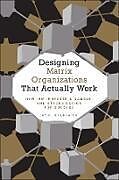Designing Matrix Organizations that Actually Work
Einband:
Fester Einband
EAN:
9780470316313
Untertitel:
How IBM, Proctor & Gamble and Others Design for Success
Genre:
Management
Autor:
Jay R. (Center for Effective Organizations at the University of Southern California) Galbraith
Herausgeber:
John Wiley & Sons Inc
Anzahl Seiten:
272
Erscheinungsdatum:
05.12.2008
ISBN:
978-0-470-31631-3
Companies know that if they have multiple product lines, do business in multiple countries, and serve many customer segments through various channels, there is no way they can avoid some kind of a matrix structure and the question most are asking is 'How do we learn how to operate the matrix?' This book shows how to make a matrix work effectively.
Autorentext
The AuthorJAY R. GALBRAITH is professor emeritus at the International Institute for Management Development (IMD) in Lausanne, Switzerland. He is also senior research scientist at the Center for Effective Organizations at the University of Southern California. He is the author or coauthor of several books, including Designing the Global Corporation and Designing Your Organization, both from Jossey-Bass.
Klappentext
ORGANIZATION STRUCTURES DO NOT FAIL, says Jay Galbraith, but management fails at implementing them correctly. This is why, he explains, the idea that the matrix does not work still exists today, even among people who should know better. But the matrix has become a necessary form of organization in today's business environment. Companies now know that if they have multiple product lines, do business in multiple countries, and serve many customer segments through a variety of channels, there is no way they can avoid some kind of a matrix structure--and the question most are asking is "How do we learn how to operate the matrix effectively?" In Designing Matrix Organizations That Actually Work, Galbraith answers this and other questions as he shows how to make a matrix work effectively. Drawing on his forty years of experience in studying and consulting with matrix organizations, Galbraith first defines what they are, tells why they are chosen, and explains why there have been failures. He provides for a complete design of the matrix organization using his Star Model, a tested framework that aligns changes in structure, processes, rewards, and people practices. The Star Model consists of policies that leaders can control and that can affect employee behavior. It shows that managers can influence performance and culture--but only by acting through the design policies that affect behavior. In order to make a matrix work, the author reveals, good relations between departments are needed, planning processes are necessary to get aligned goals, the aligned goals must go into the reward system, and people who are matrix savvy must be selected and developed. Using examples from IBM, Nokia, Procter & Gamble, and other successful corporations, he clearly illustrates the planning processes, reward systems, and human resources practices of successful implementers of the matrix.
Zusammenfassung
Based on 40 years of experience as an academic and consultant in organization design, expert Jay Galbraith explains what a matrix organization is, why you would choose to implement the matrix structure, and how to implement the matrix design successfully. Includes the Star Model, which provides for a complete design of the matrix organization.
Inhalt
Preface.Introduction: Matrix Organizations: What Are They? Where Did They Come From?What Is a Matrix?What Are the Origins of the Matrix?What Happened?The Star Model.Implications of the Star Model.PART ONE: SIMPLE MATRIX ORGANIZATIONS.1. Simple Matrix Structures.Two-Dimensional Structures.Pharmaceutical R&D Lab Example.Summary.2. The Two-Hat Model.What Is the Two-Hat Model?Examples of Two-Hat Structures.Summary.3. The Baton Pass Model.The Consumer Goods Model.The Pharmaceutical Model.Summary.4. The Matrix Within a Matrix.Design Challenges of the Matrix Within a Matrix.Matrix Within a Matrix at the Corporate Level.Mars Pet Food Example.Summary.5. Balancing Power and Defining Roles.Designing Power Bases.Roles and Responsibilities.Summary.PART TWO: COMPLEX MATRIX STRUCTURES.6. The Three-Dimensional Matrix.International Strategy.The Geography-Dominant Matrix.The Balanced Matrix.The Business-Dominant Matrix.Differentiated Structures.Other Three-Dimensional Models.Summary.7. More Complex Matrix Structures.Global Account Teams.The Front-Back Hybrid Model.Summary.8. The IBM Structure.The IBM Front-Back Hybrid.More Complexity?Summary.PART THREE: COMPLETING THE STAR MODEL.9. Communication in the Matrix.Informal Communication.Formal Communication.Summary.10. Planning and Coordination Processes.Goal Alignment, Dispute Resolution, and Coordination Mechanisms.Summary.11. Planning Processes in the Complex Matrix.What About Complex Matrix Designs?Get the System in a Room.Online Processes.Summary.12. Human Resources Policies.Human Capital.Social Capital.Summary.13. Leadership in a Matrix Organization.Seeing That Conflicts Are Resolved.Managing the Top Team.Balancing Power.Summary.14. Implementing a Matrix.Using the Star Model.Building Capabilities.Summary.15. A Synopsis of Matrix Capabilities.Epilogue: Personal Stories: The Use and Abuse of the Matrix.Early Phase: "What Is a Matrix, Anyway"?Matrix Takes Off and Becomes Trendy.The Phase of Decline.The Stealth Matrix Phase.Today: Matrix out of the Closet.References.About the Author.Index.

Leider konnten wir für diesen Artikel keine Preise ermitteln ...
billigbuch.ch sucht jetzt für Sie die besten Angebote ...
Die aktuellen Verkaufspreise von 6 Onlineshops werden in Realtime abgefragt.
Sie können das gewünschte Produkt anschliessend direkt beim Anbieter Ihrer Wahl bestellen.
Loading...
Die aktuellen Verkaufspreise von 6 Onlineshops werden in Realtime abgefragt.
Sie können das gewünschte Produkt anschliessend direkt beim Anbieter Ihrer Wahl bestellen.
| # | Onlineshop | Preis CHF | Versand CHF | Total CHF | ||
|---|---|---|---|---|---|---|
| 1 | Seller | 0.00 | 0.00 | 0.00 |
